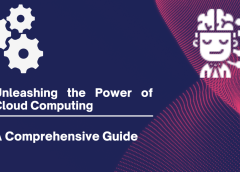In today’s rapidly evolving digital landscape, businesses are constantly seeking innovative solutions to streamline operations, enhance efficiency, and drive growth. One such solution that has revolutionized the way organizations operate is cloud computing. From startups to large enterprises, the adoption of cloud computing has become increasingly prevalent, offering a myriad of benefits that empower businesses to scale, collaborate, and innovate like never before.
Understanding Cloud Computing
Cloud computing refers to the delivery of computing services—such as storage, servers, databases, networking, software, and more—over the internet, also known as “the cloud.” Rather than owning and maintaining physical hardware and infrastructure, businesses can access these resources on-demand from cloud service providers, paying only for what they use on a subscription or pay-as-you-go basis.
Dissecting the Layers of Cloud Computing
1. Infrastructure as a Service (IaaS):
At the foundational level of cloud computing is Infrastructure as a Service (IaaS), which provides virtualized computing resources over the internet. With IaaS, businesses can leverage scalable and flexible infrastructure, including virtual machines, storage, and networking components, without the need for upfront capital investment in physical hardware.
2. Platform as a Service (PaaS):
Moving up the stack, Platform as a Service (PaaS) offers a comprehensive development and deployment environment hosted in the cloud. PaaS enables developers to build, deploy, and manage applications seamlessly, leveraging pre-configured tools, frameworks, and services. This allows for faster time-to-market and greater agility in software development.
3. Software as a Service (SaaS):
At the top layer of cloud computing is Software as a Service (SaaS), where cloud-based applications are delivered over the internet on a subscription basis. SaaS eliminates the need for businesses to install, maintain, and update software locally, as everything is managed by the service provider. This model offers convenience, scalability, and cost-effectiveness, with popular examples including email services, customer relationship management (CRM) systems, and productivity suites.
Unveiling the Disadvantages of SaaS Cloud Computing Layer
While SaaS offers numerous benefits, it’s essential to acknowledge its limitations. Common disadvantages of the SaaS cloud computing layer include:
- Dependency on Internet Connectivity: Since SaaS applications operate over the internet, a stable internet connection is crucial. Downtime or connectivity issues can disrupt access to critical applications and data, impacting productivity and performance.
- Data Security Concerns: Entrusting sensitive data to third-party SaaS providers raises security concerns, as businesses must rely on the provider’s security measures to safeguard their information. Data breaches or unauthorized access can result in data loss, compliance violations, and damage to reputation.
- Limited Customization and Control: SaaS applications are typically designed to cater to a broad audience, limiting customization options to meet specific business requirements. Additionally, businesses have minimal control over the underlying infrastructure and configurations, which may hinder customization and integration with existing systems.
Exploring the Cons of Cloud Computing
In addition to the disadvantages of the SaaS layer, cloud computing, in general, poses certain challenges, including:
- Cost Management: While cloud computing offers cost-saving benefits by eliminating upfront hardware investments and reducing operational expenses, managing cloud costs effectively can be complex. Without proper governance and monitoring, organizations may incur unexpected costs due to resource overprovisioning, unused services, or inefficient usage patterns.
- Vendor Lock-In: Adopting cloud services from a single provider may result in vendor lock-in, making it difficult for businesses to migrate to alternative solutions in the future. Interoperability issues and reliance on proprietary technologies can restrict flexibility and hinder portability between cloud platforms.
- Compliance and Data Governance: Ensuring compliance with industry regulations and data governance standards is paramount, especially when storing and processing sensitive data in the cloud. Businesses must navigate complex legal and regulatory landscapes to address privacy, security, and compliance requirements effectively.
The Future of Cloud Computing
Despite these challenges, cloud computing continues to redefine the future of technology and business. Here’s why cloud computing is poised to shape the digital landscape:
- Innovation Acceleration: Cloud computing fuels innovation by providing access to advanced technologies, such as artificial intelligence (AI), machine learning (ML), Internet of Things (IoT), and big data analytics. Organizations can leverage these capabilities to drive digital transformation, enhance customer experiences, and gain competitive advantages in the market.
- Scalability and Elasticity: Cloud computing offers unparalleled scalability and elasticity, allowing businesses to scale resources up or down based on demand. Whether it’s handling fluctuating workloads, supporting seasonal spikes, or accommodating business growth, the cloud provides the flexibility needed to scale infrastructure and applications seamlessly.
- Global Reach and Accessibility: With cloud computing, geographical barriers are eliminated, enabling businesses to reach global audiences and expand their market presence effortlessly. Cloud services are accessible from anywhere with an internet connection, facilitating remote work, collaboration, and seamless customer engagement across borders.
Demystifying Hypervisor in Cloud Computing
A hypervisor, also known as a virtual machine monitor (VMM), is a fundamental component of virtualization technology in cloud computing. It enables the creation and management of multiple virtual machines (VMs) on a single physical server, allowing for efficient resource utilization and isolation of workloads. Hypervisors abstract the underlying hardware, enabling VMs to run different operating systems and applications independently, while maximizing hardware efficiency and flexibility.
Cloud computing has transformed the landscape of modern business operations, offering a plethora of benefits that have propelled its widespread adoption. However, like any technology, it also comes with its share of drawbacks and challenges. One of the notable disadvantages lies within the SaaS (Software as a Service) layer of cloud computing.
SaaS applications are hosted and maintained by third-party providers, allowing users to access software applications via the internet without the need for installation or maintenance on their own devices. While this model offers convenience and scalability, it also presents certain drawbacks. For instance, users may face limitations in customization and integration compared to on-premises solutions. Additionally, reliance on external service providers exposes businesses to potential risks such as data breaches, service outages, and vendor lock-in.
In addition to the disadvantages within specific layers of cloud computing, there are overarching cons associated with cloud adoption. One concern is the issue of data security and privacy. Entrusting sensitive data to third-party cloud providers raises apprehensions about unauthorized access, data breaches, and compliance with regulatory requirements. Moreover, dependence on internet connectivity for accessing cloud services introduces the risk of downtime and latency, impacting productivity and performance.
Despite these challenges, the future of cloud computing remains exceedingly promising. The scalability, flexibility, and cost-efficiency offered by cloud technologies continue to drive their adoption across industries. Cloud computing enables businesses to rapidly scale their infrastructure, adapt to changing market demands, and innovate more efficiently. Moreover, advancements in cloud security, compliance standards, and data encryption techniques are continuously enhancing the resilience and reliability of cloud environments.
A fundamental component of cloud computing infrastructure is the hypervisor. Essentially, a hypervisor is a software layer that allows multiple virtual machines (VMs) to run on a single physical host. It facilitates the efficient utilization of hardware resources by partitioning the physical server into multiple virtual environments, each capable of running its own operating system and applications. By abstracting the underlying hardware, hypervisors enable greater flexibility, scalability, and resource optimization in cloud environments.







Leave a Reply
You must be logged in to post a comment.